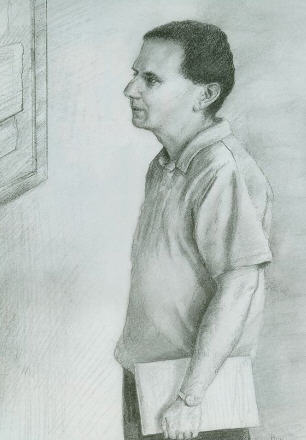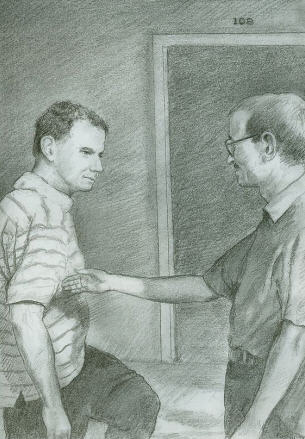Putting Krsna To the Test
By presenting ideas from Srila Prabhupada's books,
a Krsna devotee wins high grades in the secular world of academics
AS HE WALKED INTO the office copy room, Dhira Govinda Dasa glanced at the local paper lying on the table. He grimaced a bit as he read the masthead: "Dixie County, Home of the World's Only Four-Headed Swamp Cabbage."
As an entry-level social worker in rural Florida, he wondered about his new job and his future. Just then, looking up from the newspaper, he noticed for the first time a colorful announcement on the office bulletin board: "Master of Social Work (M.SW.) Program at Florida State University now accepting applications." Walking over to the board, he carefully read the details.
"Should I even consider this?" he thought.
Dhira Govinda (David Wolf) had graduated from Pennsylvania State University in 1983. He then took some time off to travel in Europe. In Israel a few months later, to satisfy his growing interest in philosophy and spiritual life he undertook a deep study of Srila Prabhupada's Bhagavad-gita As It Is in a Hare Krsna ashram. In 1985 he accepted spiritual initiation and the name Dhira Govinda Dasa, "servant of the imperturbable Supreme Lord." Late in 1990, with the Persian Gulf war looming, he returned to the United States with his wife and two-month-old daughter.
He had been a good student in college, though not exceptional. Concerned about his future in Dixie County, he now (1993) decided to take the graduate-school application tests. When his scores came back unusually high, he was surprised and pleased, and was accepted into the program.
A Waste of Time?
Dhira Govinda now faced a dilemma. The Vedic scriptures the subject of his study and fascination for many years emphasize the value of spiritual development. Declaring the rare human life meant for self-realization, great Vedic authorities lamented time wasted in "pastimes of mundane scholarship." College would mean secular teachings and, at best, tolerance of his spirituality. He contemplated the conflicts between his spiritual convictions and the prospect of more years in college.

Dhira Govinda Dasa
At last he decided to pursue a master's degree, but without compromising his Krsna conscious principles. He would stick to his convictions and see how far he could progress in the classroom. Following Krsna's instructions to Arjuna in the Bhagavad-gita, Dhira Govinda would try to remember Krsna while performing his academic duties and leave the results up to Krsna.
School started ominously. In the introductory class, the professor declared, "Social work has its roots in religious and spiritual causes. We're not proud of these beginnings."
Realizing the ironclad secular bent in social work, Dhira Govinda grew more determined to infuse his contribution to the profession with Krsna consciousness.
Among his early courses was Human Biology. Aside from completing the assignments, Dhira Govinda wrote to the professor and humbly but pointedly challenged sections of the textbook dealing with evolution. The professor responded with enthusiasm, pleased that a student was taking so much interest.
For an end-of-term project, Dhira Govinda addressed his class on the role of the elderly in society. In a materialistic culture, he explained, old people are often seen as burdensome and spent. In a spiritually based society, however, the elders are revered for their wisdom and experience. When he introduced the Vedic social system and the position of sannyasa, he noted with pleasure that the class found his presentation fresh and stimulating. People seemed interested in his Krsna conscious perspectives.
In third semester, Dhira Govinda prepared a paper for a class about communities and organizations. The paper critiqued the administrative structure of a social service organization.
As he arrived one evening for the large-enrollment class, the professor pulled him aside and asked, "Are you David Wolf?"
Dhira Govinda said he was.
"The paper you prepared was the best I've ever read in twenty-five years as a professor."
He went on to praise the paper's incisive analytical content and urged Dhira Govinda to pursue a Ph.D.
The respected professor had told the previous class, "We have a genius in our midst. You should get to know him."
Dhira Govinda was surprised. The paper was nothing special. As usual, he had simply applied points from Prabhupada's books to the particular topic. He was struck by how his Krsna conscious training enabled him to see everything in a deeply philosophical way.
In another class, Dhira Govinda applied the principle of yukta-vairagya (using everything in Krsna's service) to analyze and defuse a traditional debate within social work on qualitative versus quantitative research.
Once, during a break in a class on politics in society, Dhira Govinda was cutting jokes with Kevin and Jim, two classmates. Quoting from Srimad-Bhagavatam, he mentioned the four strategies used by leaders in dealing with rebellious subordinates: flattery, offering position, creating divisiveness, and punishment. The classmates went silent for a moment.
Then Jim said to Kevin, with some seriousness, "Did you take notes on that?"
In the midst of an ocean of speculative articles, books, and lectures on the subject, the two sensed receiving more practical political knowledge in one or two sentences from the Srimad-Bhagavatam.
Vedic Source Material
Quoting from Vedic sources in papers and discussions, Dhira Govinda found an endless supply of interesting and relevant ideas. In one class, he was asked to write comments on the following quote from William James: "Our normal waking consciousness, rational consciousness as we call it, is but one special type of consciousness, whilst all about it, parted by the filmiest of screens, there lie potential forms of consciousness entirely different. …"
Dhira Govinda wrote, "For many years I've been interested in forms and levels of consciousness. Then at one point I thought, 'But who is it that's conscious?' It struck me that no scientist has ever mixed chemicals and created a conscious thing not even an amoeba or a mosquito, what to speak of a human being. The body I had when I was a five-year-old boy is no longer there. Every atom is different. Yet there is something, some identity that is conscious of all my experiences of life. This identity must not be a function of my gross body, since my identity has remained constant, though the body and mind have changed."
The teacher commented, in red ink, "Wow! [As] always, you bring great depth of experience."
In other responses Dhira Govinda expounded on the philosophy of acintya-bhedabheda-tattva ("simultaneous oneness and difference"), quoted from Brahma-samhita and Caitanya-caritamrta, and pointed out the temporality of all material things. Citing the Bhagavad-gita, he wrote on humility as an essential quality for an effective therapist.

Dhira Govinda's professors were excited with his work. Recognizing his interest in presenting a spiritual and ethical message in the field of social work, one professor assigned him readings to help him present his spiritual message in a secular voice. Another professor asked him to review a course she was designing on epistemology in social science. Among other concepts straight from Srila Prabhupada's books, Dhira Govinda suggested she include lessons on the defects of the material senses. She appreciated his suggestion and incorporated the ideas, especially those about the limitations of the empirical methods.
Dhira Govinda began feeling more relaxed and accepted as a Hare Krsna social worker. He took to carrying his japa bead bag with him and chanted as he walked about the campus during the day. To his surprise, a social services administrator noted this and told him that she and her husband often visited Krsna temples.
In a course on the philosophy of social science, Dhira Govinda was assigned to write extemporaneously on "the personal ontology and epistemology that underlies your approach to social work practice and research."
Diving right in, he wrote: "Underlying my practice approach is the assumption that a person is not the body. Therefore, I consider it illusion for someone to think 'I am white,' 'I am black,' I am female,' 'I am male,' 'I am an Arab,' 'I am a Jew,' or any such bodily conception. These designations relate only to the temporary material covering of the person… . To illustrate by analogy, if a person were driving in a car produced in Italy, it would be incorrect to think 'I must be Italian.' The person could then get into a Toyota and think 'Now I'm Japanese.' The car has no intrinsic connection with the driver. Similarly, this material body has no intrinsic connection with the self…. Lack of understanding of our separateness from the body is the root cause of suffering…. My practice model involves helping a person realize the difference between the body and the self. For all types of social work and mental health scenarios, I consider this understanding to be essential…."
Impressed, the professor commented that he especially liked the vehicle analogy. Then, at the end of his written comments, he asked frankly, "What are you doing here?" He couldn't understand what someone with such a philosophical outlook was doing in a postgraduate social work program. He assured Dhira Govinda that he'd find his philosophical viewpoints unique in the field.
Dhira Govinda relished being out of place, a proponent of absolute truth in a thundering herd of liberal speculators. In a final paper on issues of ethics, values, and morality in social work practice and research, Dhira Govinda began by quoting a student orator at a Harvard graduation: "Among my classmates I believe that there is one idea, one sentiment, which we have all acquired at some point in our Harvard careers, and that is, in a word, confusion…. They tell us that it is heresy to suggest the superiority of some value, fantasy to believe in moral argument, slavery to submit to a judgment sounder than your own. The freedom of our day is the freedom to devote ourselves to any values we please, on the mere condition that we do not believe them to be true."
Building on this theme, Dhira Govinda pounced upon the contradictions of the pervasive, relative doctrines of modern academics: "Philosophically, the paradox is irresoluble. 'Are you sure there's no absolute truth?' 'Yes.' 'Are you absolutely sure?' … Rigid attempts to cling to relativist doctrine lead to the confusion described by the Harvard graduate. This bewilderment and consequent feelings of emptiness and insecurity largely characterize modern society."
Presenting both a critique and a solution, Dhira Govinda concluded: "If we enter concepts such as essence or soul into the discussion, material objectivism is no longer applicable. Social workers who profess an objectivist paradigm may be courteous, empathic, warm, and caring, but their paradigm provides no fundamental reason to develop such qualities."
Going on to explain the importance of understanding the soul in developing the compassionate relationships necessary for social work, Dhira Govinda concluded with a direct presentation of Krsna consciousness: "When such a relationship is established within the heart, rules and regulations are no longer required. One will spontaneously act for the welfare of other persons…. To develop such a relationship with all persons necessitates cultivating a loving relationship, through the process of devotional service, with the source of all living entities, the Personality of Godhead. The Personality of Godhead is compared to the root of a tree. By watering the root, there's no need to separately water each leaf and branch."
Commenting on the paper, the professor wrote, "I think that your idea of sacrifice and compassion devoid of sentimentality is a noble pursuit. It is tonic for the endless sentimentality that a social work faculty is exposed to. Best wishes."
By referring to his Krsna conscious roots, Dhira Govinda found himself passing quickly through graduate school. His fifty classmates enjoyed his various classroom presentations of Krsna consciousness. When he graduated the master of social work program with a 4.0 average, he was elected class valedictorian. Addressing the class at graduation, he quoted the Caitanya-caritamrta's instruction that to understand and teach others about the eternal soul is the highest social welfare work.
Vedic Theory of Social Work
Now, at the urging of his academic advisor, Dhira Govinda entered the doctoral program. In one of his first Ph.D.-level courses, on research methodologies, he suddenly found himself confronted with an unexpected question: What would his research project be? His three fellow students had prepared for the question for months or years. Dhira Govinda had one minute to decide.

Remembering some conversations he'd had with scholarly Vaisnavas, Dhira Govinda announced he would research the three modes of material nature (goodness, passion, and ignorance) as a measure of a person's well being. Since the Bhagavad-gitathoroughly defines the effects of the modes of nature on a variety of human behaviors, he asserted, they are at least as amenable to research as other psychological conceptualizations. The professor, who happened to be a yoga teacher, enthusiastically agreed with the idea and offered to help.
The result of this research was the "Vedic Personality Index," featured in the May/June 1998 issue of Back to Godhead. It was also published in the Journal of Indian Psychology (January, 1998) and Psychological Reports (June, 1999).
The Vedic Personality Index proved to be an essential element of what Dhira Govinda developed as the "Vedic Theory of Social Work." Graduate students rarely introduce a theory; usually they simply choose an existing one to study. But Srila Prabhupada's many writings and the many Vedic references on subjects such as sociology, psychology, and social work provided more than enough source material for the "new" theory.
The Vedic Theory of Social Work teaches that the soul is different from the body. It also includes the effect of transcendental sound (japa) on the soul's progress through the modes of nature. This latter element proved to be the basis for Dhira Govinda's thesis (see sidebar on previous spread).
After presenting the Vedic Theory of Social Work to a class through a play, Dhira Govinda received the following comments from other students:
"I thought the sound therapy [japa] is particularly interesting. Great analogy about the chariot and the body. 'The owner is different from the body.' I really like that. It hits home. Great presentation."
"As far as heightened consciousness and spirituality, this was a valuable lesson. Maybe I'm searching. I'm interested in the parallels of the East and West approaches of therapy. Good job. Great paper!"
"It is good to be reminded of the spiritual aspects of our nature and applying these within our practice. You're always interesting!"
"I learned about disciplined application of a spiritual way of life to use with our clients."
"I learned a lot about applying spiritual practice to social work."
"I liked the analogy of the horse and carriage. The Vedic Theory was very interesting; thanks for the snack to feed my vehicle."
Dhira Govinda successfully defended his thesis in June 1999. What had begun as a tenuous venture into academia turned into a series of perfect grades and much appreciation and success. Reflecting on his experience, Dhira Govinda comments simply, "Everything I said or wrote came directly from Srila Prabhupada's books."
Kalakantha Dasa writes, runs a small business, and oversees circulation for BTG. He and his wife, both disciples of Srila Prabhupada, live with their two children in Gainesville, Florida.
